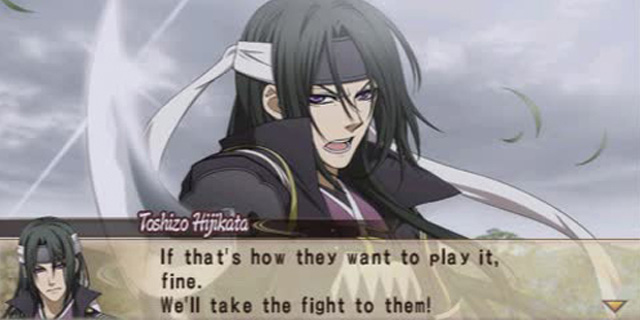
Last year, Aksys took a risk and published Hakuoki: Demon of the Fleeting Blossom. Not only was it unique in that it was a visual novel, a genre that is still trying to get a foothold in our market, but it was also an “otome” game; a story specifically created for a female audience. Fleeting Blossom was a romance story revolving around Chizuru, a girl that finds herself involved with the Shinsengumi as they fought to assist the Shogunate at the tail end of a political era. It was very well-written, with a large cast of equally dynamic characters, and did well enough for Aksys to bring over another game in Idea Factory’s multi-game franchise.
This year we have Hakuoki: Warriors of the Shinsengumi, which prides itself as being a Dynasty Warriors-style action game that explores the plot of the original (though it actually appears to be based on the anime adaptation), and also brings a new, alternate-universe story that introduces some new characters and battle scenarios.
It doesn’t really work, unfortunately.
Warriors of the Shinsengumi begins with deceptively-slick intro animations and menus that somehow don’t suffer from a lot of the slight blurriness that most PSP games have when played on the Vita. Once you start the actual game, however, it looks even worse than most of the lower-end games we saw in the early days of the PSP. The environments are empty textures, the playable characters are ugly messes of washed-out colors and jerky animations and next to no enemy variety is present. The attack animations are so underwhelming that my eyes glossed over every time I mashed the square button. Which was often.

Story-wise, Shinsengumi is an enormous disappointment, considering the game’s namesake. Similar to a Dynasty Warriors title but not nearly as stylish or polished, Shinsengumi progresses like a barely-coherent Cliffs Notes version of the original story, peppered with blurry screenshots and anime excerpts of wildly varying encoding quality. The new story makes even less sense, since there’s no outside context, and it progresses like a vague trail of samurai battle jargon. The new character designs are pretty cool, though.
The gameplay is where Shinsengumi really drops the ball. The crude graphics and nonexistent writing would be forgivable if the fun factor was at least on par with the typical Musou fare. It doesn’t even come close. It’s sluggish and jittery, and nothing even resembling progression or variety is present. Enemies come at you constantly, and all you have at your disposable to deal with them are the same two combos. There’s no variation no matter which button you press at what point in your attack string, and your special attacks are merely the same animations with some added glowing effects. The combat is also incredibly awkward, as there is no consistency regarding how mobile you can be while attacking. Most similar games allow you a certain range of motion to account for the fact that you tend to be surrounded by goons, but most of your attacks in this game, especially the stronger ones, hold you still and make using them more annoying and cumbersome than useful.
Stages usually give you a minimum kill requirement before the next area opens up or the boss appears, and it’s really hard not to just run past everything to the end once you meet the requirement. Once you beat the boss, which until the later stages in the game behave more like regular enemies with larger health bars, you go to the next level and do the same thing again and again until you either finally finish your chosen character’s story or get sick of the game and find something better to do with your time. Moving onto the next character doesn’t change anything, unless you pick the one guy that doesn’t use a sword, of course.
It pains me to say this, but a combination of lazy writing, ugly visuals, and less than mediocre mechanics make Hakuoki: Warriors of the Shinsengumi a huge disappointment, and runs the risk of being an irremovable black mark on what seemed like a promising new series.
Pros: The first game did well enough to warrant further localization efforts
Cons: Screams “lazy franchise cash-in,” but there isn’t much of a franchise to cash in on yet



















